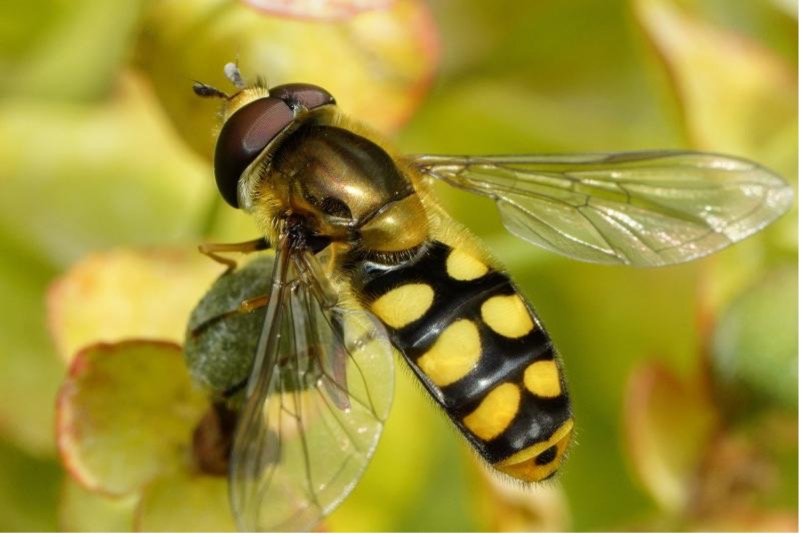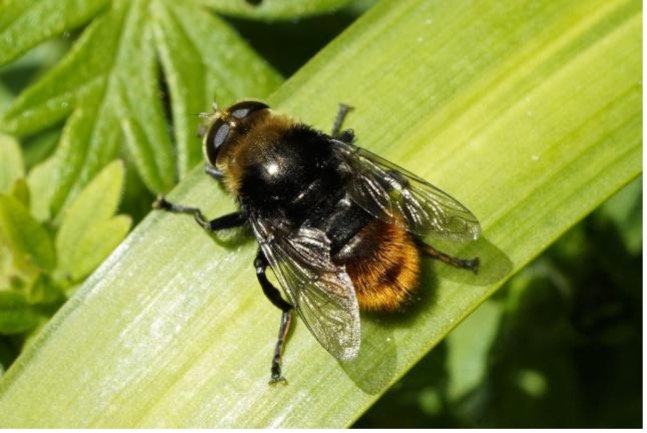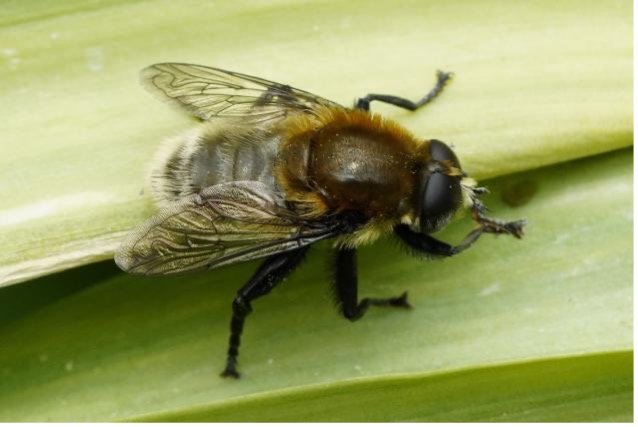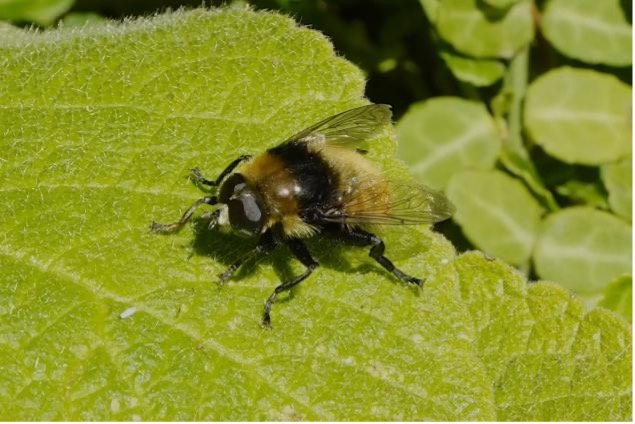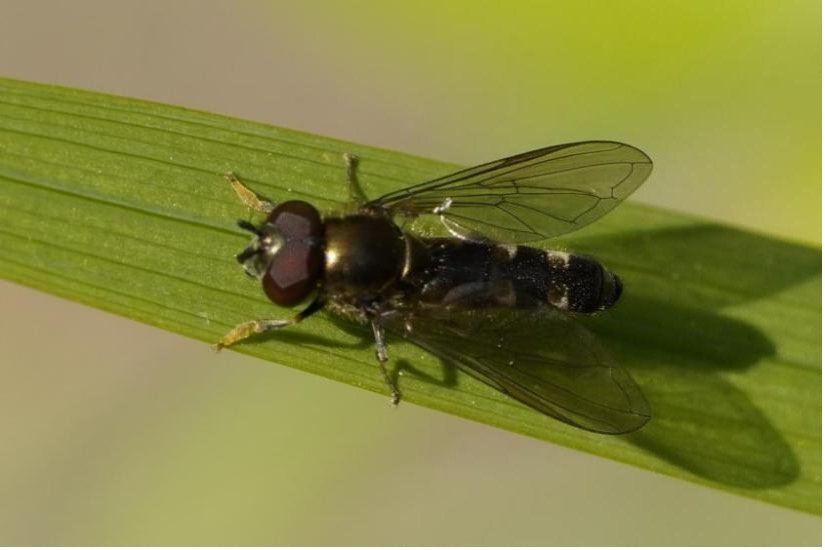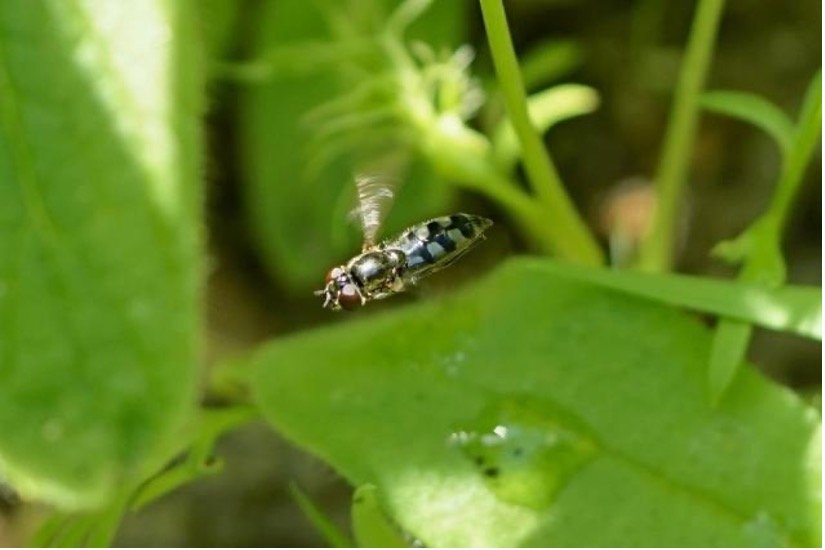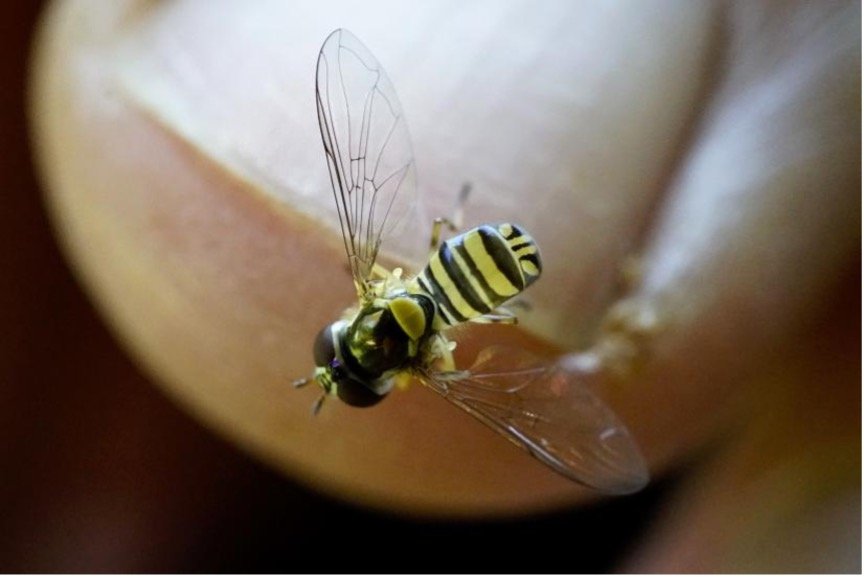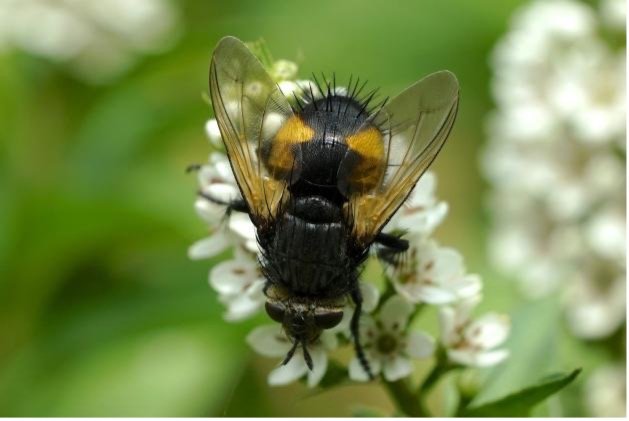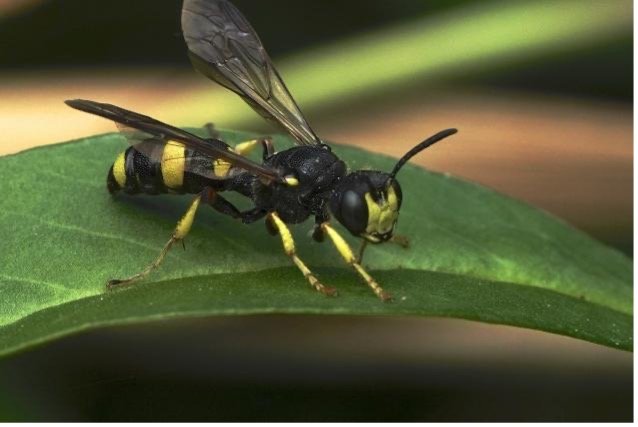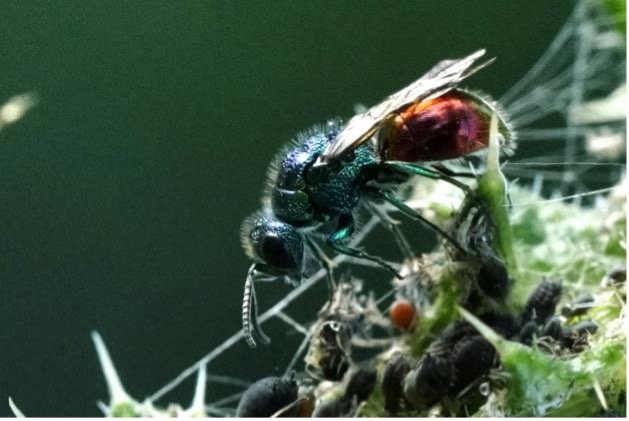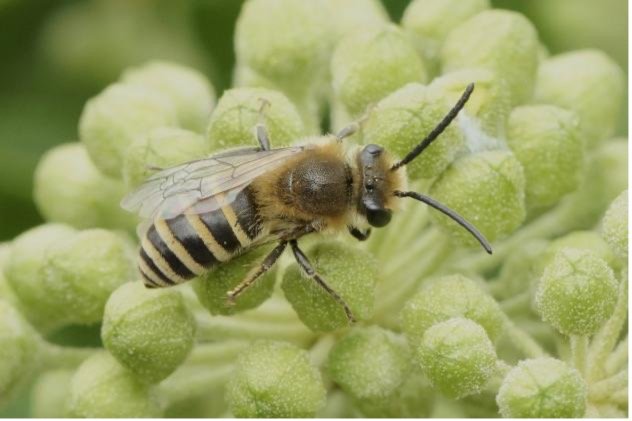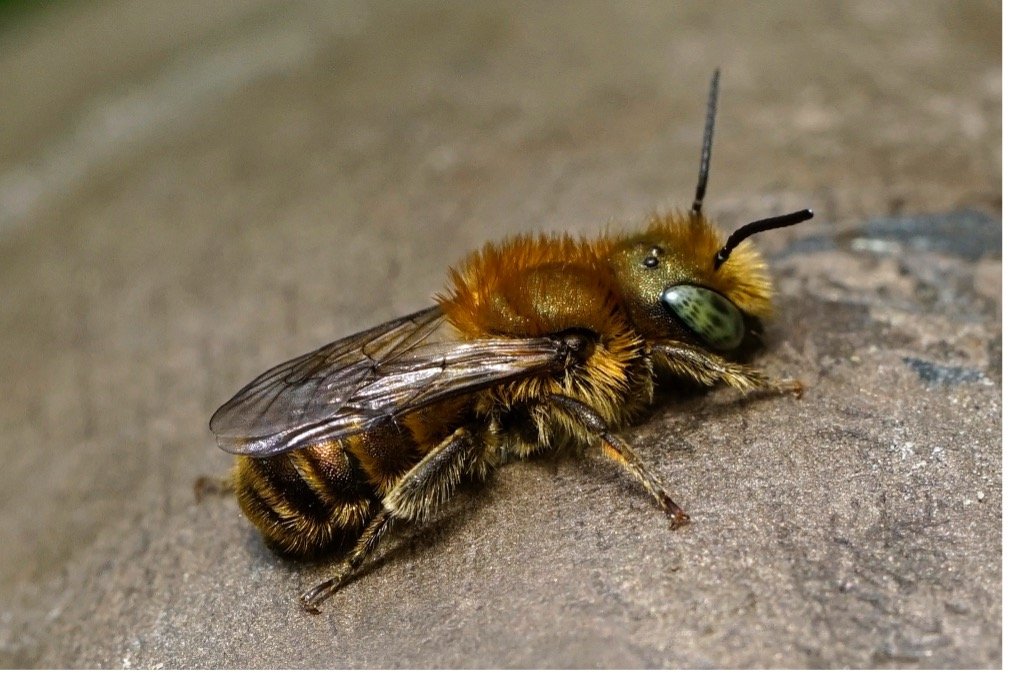Hoverflies are not a terribly prominent part of Bishop Meadow’s insect fauna but they are probably more significant than one might think. Like many insects, most of a hoverfly’s life is conducted unseen as larvae making a living by various means. Hoverfly adults are invariably pollen / nectar / honey dew feeders and therefore qualify as important pollinators. If you haven’t got a profusion of flowers, you won’t see a profusion of flower feeders hence the situation on Bishops Meadow. In anticipation of an increase in botanical diversity in the meadow and in recognition that hoverflies are colourful, charismatic flies that frequent flower-rich gardens, I thought an illustrated introduction to the group is worthwhile.
There are loads of different fly families often comprising thousands of species. Syrphidae is the Hoverfly family with about 280 UK species. They are often colourful, vary in size from a few mm in length to ones approaching hornet size. The colours and patterns many species bear are often interpreted as mimicry of bees or wasps which is interesting of itself. Mostly strong flyers, several species are migratory or migratory with a resident UK population. However, the way they make their living as drab maggots, the larval stage, is where the action is, ecologically speaking .
Numerous species feed on aphids, others on ant, bee, wasp or beetle larvae. Other species’ larvae that also develop in wasp nests apparently feed on detritus the wasps generate rather than the wasp brood itself with possible exceptions. About 40% of species live in decaying vegetable material in wet to damp conditions such as, pond margins, wet ditches, rot holes in trees, humus, leaf mould and such like apparently feeding on the bacteria and fungi that decay organic material. A few species live on living vegetation. In particular several thistle species, Ransoms [Allium ursinum] and other bulbs including daffodils and tulips are exploited as their food plants.
Hoverfly larvae finishing off an aphid; Parasitic wasp inserting an egg into a hoverfly pupa
It’s quite instructive and a cautionary nod to how we understand the ecological relevance of organisms. The bits of their life that we can routinely observe belies their ecological contribution. There is a great variety of hoverfly species’ role in the trophic [energy deriving] flow in their habitat but their contribution to the ecological balance between plant growth and the population of small things that eat plants makes the species of predatory hoverflies irreplaceable. At the same time they provide food for spiders and certain species of wasp. Effective regulation requires both an accelerator and a brake.
Many hoverflies are easily identified as such but there are two areas where confusion may arise. Some species are convincing bee / wasp mimics and others resemble some sort of other fly. All flies have two wings unlike bees and wasps which have four wings, though this is not always easy to see. They also have different mouth parts and mostly different eye shape and configuration to hoverflies. The most reliable way to distinguish a hoverfly from other fly families in the field with only the naked eye, if it isn’t obvious, is to look for bristles however fine. Not all flies have bristles, hoverflies, though usually hairy, don’t have bristles. The more technical feature is the presence of a false wing vein [vena spuria, see Chrysotoxum below] but this is rarely visible to the naked eye.
How do you identify these things then? Well, insect taxonomy becomes pretty funny if you get serious with it. You’re looking for a tangle of hairs on the underside of the front tibia or whether the hairs on the margin of tergites 4 and 5 are entirely black or also includes yellow or what angle a particular wing vein intersects the adjacent vein. To get serious about it means terminology so let’s not go there.
For those interested in photography, the photos in this article were taken in natural light, hand-held and manually focused with a Sony 90mm f=2.8 macro lens on a Sony Alpha 7R IV or R II. Almost all the shots were in my small garden.
Largest and smallest: Volucella and Paragus
Volucella zonaria is the largest British hoverfly at 20mm or more in length but 50 years ago it wasn’t even a British species. In flight it looks like it might be a hornet. If you see a hornet attending flowers, it’s this guy. This formerly continental species may also represent what to expect with climate change. Between the first reports in the late 1930’s through the late 1990’s the species became established in the London area. By 1998 there had been only three records in Surrey outside of urban areas of the county. It has now spread throughout southern counties; I see it more then once every year. Larvae: wasp associated.
I don’t really know if Paragus is the smallest British species but it is very small. The flower in the photo is 15mm so this one is 3-4mm. Larvae: aphid predator.
Wet circumstances: Helophilus and Myathropa
In my garden I have Helophilus, a medium-sized fly, around a small pond all through summer. The larvae are referred to as “rag-tailed” due to a posterior breathing tube that allows them to breathe whilst underwater or in anaerobic conditions. Larvae: detritivore [feeds on organic matter and associated microorganisms].
Myathropa is a beautiful fellow. A large fly with a distinctive batman pattern on the thorax [the middle section of the body: head, thorax, abdomen]. They breed every year for me in an especially smelly water butt. Larvae: detritivore
Yellow and black aphid predators: Eupodes and Epistrophe
Here are a couple of representatives of this difficult group that comprises about a dozen genera that have abdomens with spots or bands across the abdomen. This feature earns them the description of ‘wasp mimics’ although in identification guides this descriptor is modified by ‘unconvincing’ for some. If you have a good population of these guys in your garden you will see at most brief flushes of aphids that quickly disappear. Eupodes is a medium-small sized fly that looks black with yellow or white markings as opposed to the banded species that give the impression of being yellow with black markings. Larvae: aphid predator.
I always get excited when I spot this species of Epistrope [elegans]. It’s charismatic and distinct, medium-small in size and not one that rushes around, it is easily overlooked. Larvea: aphid predator, especially tree aphids.
Most variable: Merodon equestris
The genus Merodon has a single British species but within this there are a number of consistent variations in colouration. This fly was first detected in the UK in 1901 in a London garden probably introduced in tulip bulbs but has spread throughout England and into southern Scotland. Most hoverflies can be quite variable in size, in how dark or light the colours, the extent of the patterning and often between the sexes. I think this is the only one that have several identifiable ‘varieties’ as such. Three of them appeared in my garden simultaneously this spring. It is a large fly. Larvae: bulb herbivore.
Commonest hoverflies most likely to go unnoticed: Platycheirus albimanus and Syrittia pipiens
Sorry, I’ve used species names here and for opposite reasons. Platycheirus is the second largest British genus with 25 described species and Syrittia pipiens is the only British species of the genus Syrittia. P. albimanus is a small fly but if you know what to look for, you can spot it hovering which it does frequently. The character that you can see from a [short] distance is two rows of three, squarish silvery spots on the abdomen. The male has pale broadened front tarsi [the several segments sort of equivalent to a ‘foot’]. The second photo is the female in flight. The name ‘albimanus’ means ‘white hand’. Larvae: aphid predator
Syrittia pipiens is the same size as P. albimanus. It’s markings I would describe as orangy-yellow but the massively enlarged hind femur with short spikes on the underside is the main distinguishing character. The male has an abdomen with an enlarged end which is not the case in females. Larvae: damp, not wet, situation detritivore
Hoverflies with common names: Drone fly, Marmalade fly, Great pied hoverfly
Species of Eristalis, quite convincing honey bee mimics, are referred to as Drone flies. You may well have noticed them due to their habit of occupying a position in the air, darting out to see off some intruder and returning. The various species are large or medium sized flies about the size of a honey bee or slightly smaller. Larvea: wet and damp situation detritivore
The Marmalade fly is a small, attractive and very common fly, Episyrphus balteatus, the only species of that genus. It’s one of the earliest to appear and one of the latest to hang on in the season. If they mature in colder conditions they can appear much darker than in the photo below. Larvea: Aphid predator
The Great Pied hoverfly aka Volucella pellucens like all the Volucella species is a very big fly. Larvea: wasp nest associated
Sundries: Sphearophoria, Rhingia, Chrysotoxum
But first a closer look at the hoverfly head while avoiding the avalanche of terms entomologists have bequeathed to it. It’s interesting to see an insect close-up. The mouth parts of the adult of hoverflies are pretty similar presumably because they feed in the same way. Sometimes there is a sheath-like structure [see Rhingia]. The compound eyes likewise differ in shape and placement to some extent but are pretty similar. This fly has ‘normal’ antennae but there are a few quite different antennae structures to be seen amongst hoverfly species.
Sphaerophoria is the species that you are most likely to see on the meadow. Actually a small group of very difficult to separate species that are small, colourful, elongate flies that can be seen in grassy areas but still attending wildflowers. Larvae: aphid predator.
Rhingia has a very distinctive look. A medium to small-medium sized fly that I don’t see every year described as ‘dumpy’ in the guide. Maybe so but I had a good picture of it. The long sheathed tongue allows it to feed on deep flowers. It may favour margins of woods and hedges. Larvae: detritivore in damp circumstances including dung
Quite a good wasp mimic, Chrysotoxum is a large, spectacular hoverfly that catches the eye. The vast majority of hoverflies are decorated by coloured hairs on the side of the thorax but decoration of both Sphaerophoria and Chrysotoxum is a part of the exoskeleton itself. Larvae: not clear but some evidence that they develop in root aphid ants’ nests [the yellow field ant is one such]. The ‘vena spuria’ is particularly prominent - it’s the vein in the middle with one end sort of hanging.
Predators:
Here an ambush hunter, the spider Misumena, catches a Syrphid. She’s perfectly camouflaged in this Loosestrife which is a real attractant for both bees and flies. As with all insects, Hoverflies are susceptible to insect parasites as shown on page 1 as well as the so-called entamopathogenic fungi. These fungi are mostly to be found in the soil but have the capacity to overcome an insect host’s defenses in some cases. Some of these species of fungi and wasp have been developed for use as ‘bio-pesticides’.
An American contribution
From one garden in North Carolina, one of the smallest and the biggest Hoverflys I have ever seen. Allograpta is a delicate beauty and the spectacular Milesia which is even bigger than Volucella zonaria.
Now that you have seen some Hoverflies here are some non-hoverflies:
These are flies, not Hoverflies:
These are wasps, not Hoverflies:
These are bees, not Hoverflies:
This piece is indebted to:
Ball, S. and Morris, R., 2015. Britain’s Hoverflies. Princeton University Press.
Morris, R.K.A., 1998. Hoverflies of Surrey. Surrey Wildlife Trust.








